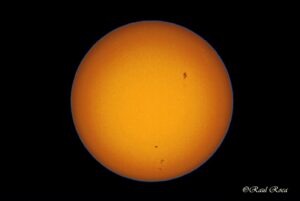
11 TYPES OF SOLAR PHENOMENA & HOW THEY AFFECT SOLAR ENERGY
Did you know the interactions between the Sun and our planet’s atmosphere, as well as other constituents of our solar system, can create a number of visually stunning solar phenomena?
There are many types of solar phenomena and each one is the result of different conditions regarding the sun. Here is a rundown of some of the most common and some of the lesser-known solar “special effects.”
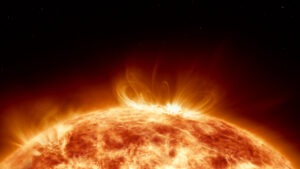
Solar Flare
Solar flares are intense bursts of radiation emanating from the release of magnetic energy associated with sunspots on the surface of the sun. They are caused by the interaction of highly charged particles within the sun‘s magnetic field. When these magnetic field lines become twisted and entangled, they can suddenly snap and realign, releasing vast amounts of energy in the form of solar flares.
Solar flares can emit radiation across the entire electromagnetic spectrum — from radio waves to x-rays and gamma rays — and are powerful enough to affect Earth‘s ionosphere, potentially disrupting communications, satellite operations, and even affecting your solar panels.
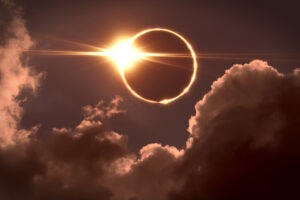
Solar Eclipse
A solar eclipse occurs when the moon passes between the Earth and the sun, temporarily obscuring the sun‘s light. This celestial event can only happen during a new moon when the sun and the moon are in conjunction as seen from Earth.
There are three types: total, partial, and annular. In a total eclipse, the moon completely covers the sun, allowing the sun‘s corona to be visible. During a partial eclipse, only a portion of the sun is obscured. An annular eclipse occurs when the moon covers the sun‘s center, leaving a ring-like appearance. The alignment of the sun, moon, and Earth, along with the distances between them, are responsible for the occurrence and type of solar eclipse observed.
While this type of phenomenon is often only visible in high-latitude areas, geomagnetic storms can increase the area of visibility.
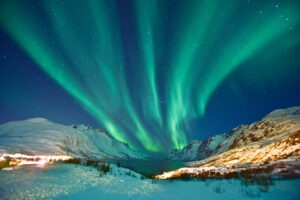
Solar Aurora
A solar aurora, commonly known as the Northern or Southern Lights (Aurora Borealis and Aurora Australis, respectively), is a dazzling natural light display in Earth‘s sky, predominantly seen in high-latitude regions around the Arctic and Antarctic.
Auroras are caused by the interaction between solar wind — a stream of charged particles flowing out from the sun — and the Earth’s magnetic field and atmosphere. When these charged particles collide with atoms and molecules in Earth‘s atmosphere, they excite these atoms, causing them to light up. The resulting shimmering curtains of color are typically green, but can also be pink, red, yellow, blue, and violet.
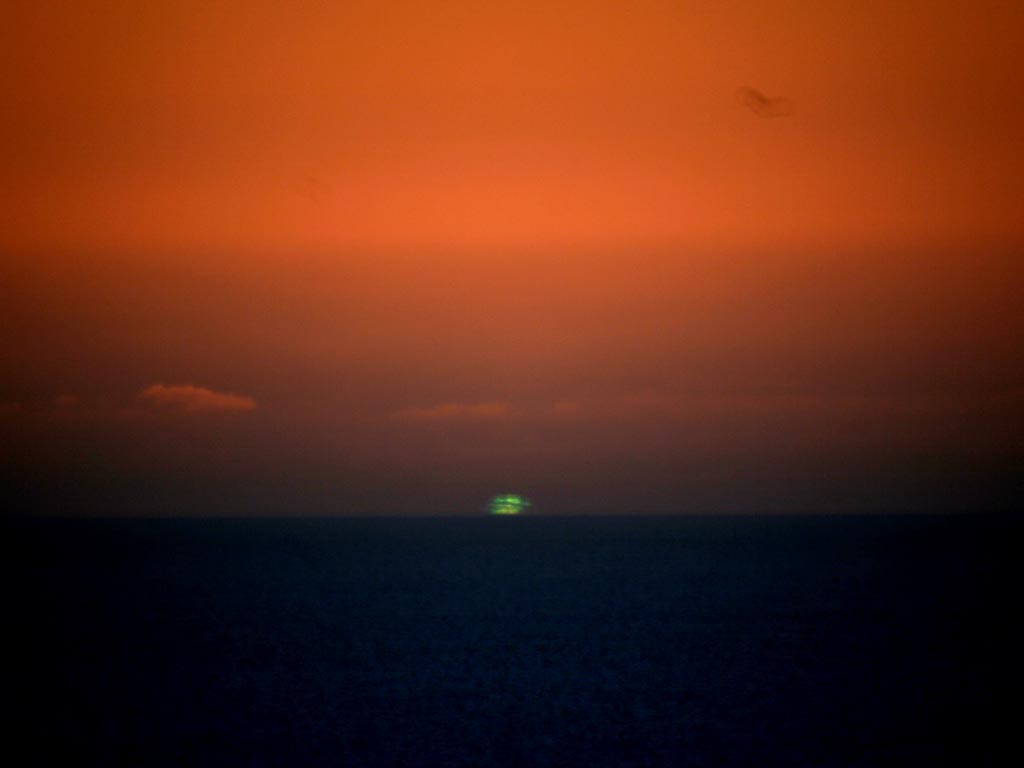
Green Flash
When the sun rises and sets, a green flash is nearly always lost to the naked eye. The distinctive coloration results from Earth’s atmosphere acting like a prism, splitting white sunlight into its spectrum of hues. Most of the time when the sun is near the horizon, only longer-wavelength light (red and orange) makes it through to our eyes. Shorter wavelengths get refracted or bent out of sight. But for a brief moment, a band of green can make it through. In very rare cases, when atmospheric conditions are just right, a blue flash can be detected as well.
Rather than risk hurting your eyes squinting at the sunset, let a camera try to capture the green flash. The odds of seeing green flashes improve when the air is stable and clear with a sharp horizon line. Gazing over the ocean provides a good vantage point for capturing the green flash. Observing from a high vantage point can also increase your chances, as it allows a clearer view over the Earth’s curvature.
Green flashes come in several varieties. One is sometimes referred to as a green rim, seen in the above image. The green rim actually happens with nearly every sunset but is very tough to spot. Another, rarer sort of green flash reveals itself right as the sun disappears below the horizon as a fleeting verdant specter (below). Casual onlookers can often catch such a green flash, for instance, from Kauai, Hawaii.
Solar activity, such as solar flares and coronal mass ejections (CMEs), can also influence the visibility of green flashes. In fact, according to the Journal of Space Weather and Space Climate, increased solar activity, especially during the peak of the solar cycle, can intensify the Earth’s upper atmosphere, causing more dramatic atmospheric effects.
Solar Wind
Solar wind is a continuous flow of charged particles, primarily electrons and protons, that is created by the high temperature of the corona (the sun’s outer atmosphere). That energy causes particles to stream outward through the solar system.
Solar wind can vary in speed and intensity and is responsible for triggering geomagnetic storms when interacting with Earth’s magnetosphere. Unlike some other solar phenomena, solar wind is invisible.
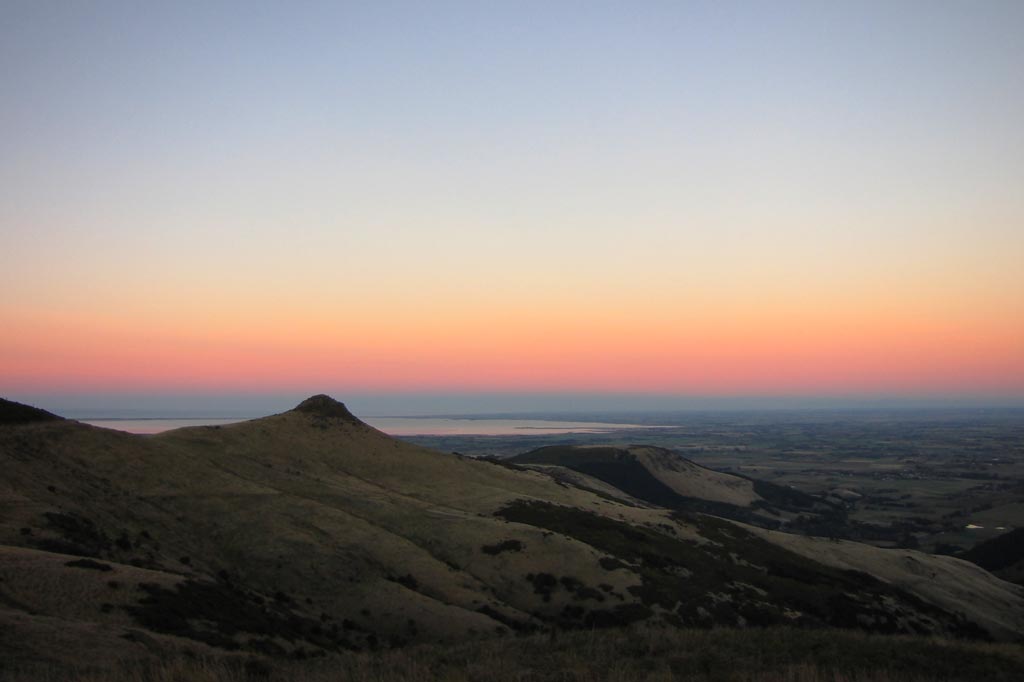
Belt of Venus
You’ve likely noticed this pinkish band hugging the eastern horizon after sunset, opposite where the sun has sunk in the west. It is reddish solar light backscattered — that is, reflecting back toward where it originated from with the setting sun — by particulates in the atmosphere. This phenomenon gets its name from the fact that the planet Venus, visible at dawn and dusk, is often located within or near the colored celestial stripe.
Below the Belt of Venus, the sky looks darker and purplish. This band is actually a shadow cast by Earth as its dayside rotates away from the sun and enters night.
Sunspots
Sunspots are dark, cooler areas on the surface of
the sun caused by intense magnetic activity. These magnetic fields are so strong that they prevent the hot plasma from within the sun from rising to the surface. As a result, sunspots are significantly cooler than other areas of the sun, making them appear dark by contrast. Sunspots are often the sites for solar flares and coronal mass ejections, which can have profound effects on space weather.
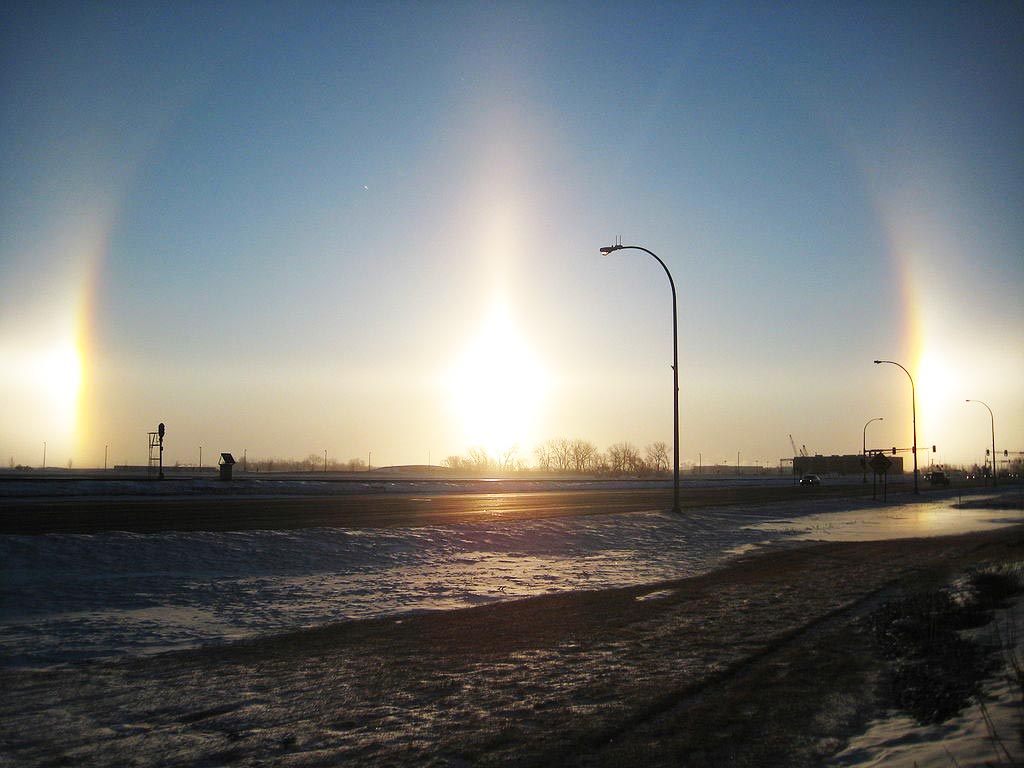
Sundog
The ancient Greeks and Romans wrote about “mock suns” following the real sun. Surely what their eyes saw is the phenomenon now called a sundog. It manifests as a bright spot (or spots) in alignment with the sun and appears to the sun’s left, right, or on both sides.
Sundogs are specifically caused by hexagonal ice crystals in the atmosphere, which refract sunlight akin to a prism. This refraction can produce a great number of related phenomena, broadly classified as halos. For instance, sundogs’ typical distance from the sun — 22 degrees — falls on a halo of the same name. A glowing line can sometimes be seen extending from the sun to the sundogs, called a parhelic circle. In these situations of highly refracted sunlight, a vertical luminescence may also protrude from the sun, dubbed a sun pillar. All these solar visuals are present in the above image.
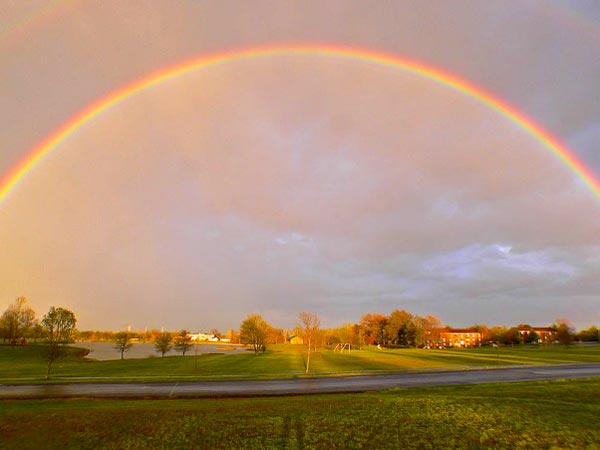
Rainbow
You’ve likely seen rainbows before. As with other phenomena in this article, rainbows form from an interplay of reflection and refraction. Instead of ice crystals, in this case, water drops serve as the prism. When light enters the droplet, some of it is reflected by the drop’s far side, back the way it came in. In the process, the light gets refracted by the water, with the different wavelengths (colors) bending at different rates. As a result, when the light comes back out, it is splayed into the visual spectrum.
We see all this in action when rain is falling in front of us and the sun is shining behind us. The angle of the sunlight must be just right — about 42 degrees — in order to get the spectrum-throwing effect, more common when the sun is lower in the sky in the morning and afternoon.
To get a better feel for how rainbows occur, experiment with a garden hose on a sunny day. With the sun to your back, put your finger over the water flow to generate a fine mist. If you get the angle just so, you’ll generate a rainbow. Waterfalls, fog, and sea spray can also create colorful arcs.
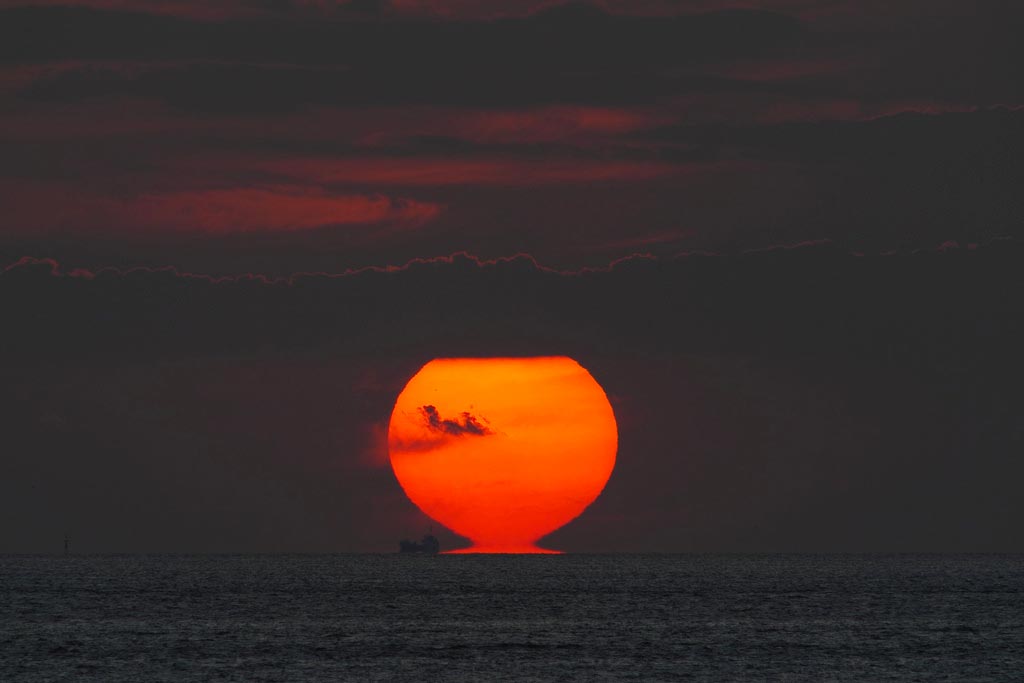
Omega Sun
Another stunning visage our star can offer is the so-called Omega Sun, named after the last letter of the Greek alphabet. When the bottom limb of the sun is still “touching” the horizon, a mirage effect can temporarily occur, making the sun appear to pinch in and then expand back toward the ground.
Mirages occur when light passes through a layer of hot, lower-density air near the Earth’s surface. The light refracts, triggering a seeming reproduction of a part or whole of a distant object or the sky. As an optical phenomenon, we’re more familiar with mirages for fooling desperate desert travelers into believing an oasis lies ahead. Instead, the apparent blue on the yonder landscape is just the refracted blue sky.

Zodiacal light
To see this optical phenomenon, you’ll need to be under an inky black, moonless sky and away from the light pollution of civilization. After nightfall or before sunup, a sizable, tapering white glow can be witnessed extending up from the horizon. Called the zodiacal light, it is actually not an interaction between the sun and Earth’s atmosphere, like the other examples given in this article. Instead, the luminance is a reflection of sunlight from the grains of cosmic dust out in our solar system.
This dust ranges in size from molecular motes to sand-like grains on up to bona fide space rocks. It is created by comets’ dusty, icy tails leaving material throughout the inner solar system, as well as the pulverizing collisions of asteroids.
The zodiacal light is so named because its light appears in the celestial zone dubbed the zodiac, which extends about 8 degrees north and south of the ecliptic, the plane of the circular path followed by the sun as it moves across the sky. Year in and year out, the sun makes these laps across our firmament, producing beautiful visuals for us to experience and enjoy.
Do Any Types of Solar Phenomena Impact Solar Panels or Solar Energy?
Most solar phenomena have zero effect on solar energy production for a variety of reasons. For example, green flashes are incredibly brief and the Belt of Venus takes place at sunset, which isn’t a peak time for solar panel output.
However, certain solar phenomena can have a minor effect on solar panels and solar energy production. Here are some that can have a potential impact:
- Solar Flares and Coronal Mass Ejections (CMEs): While solar flares themselves don’t directly impact solar panels, the geomagnetic storms they can induce may affect the electrical grids to which solar panels are often connected. This can lead to voltage irregularities or, in extreme cases, power outages. Additionally, increased solar radiation from these events can temporarily enhance the solar panel output, but this effect is usually minor.
- Sunspots: While sunspots can affect the amount of solar radiation emitted by the sun, the impact on solar panel output and solar energy production is generally minimal.
- Solar Wind: The solar wind itself doesn’t directly affect solar panels. However, intense solar wind events can contribute to geomagnetic storms, which can impact electrical grids and potentially affect the performance of solar panel systems indirectly.
- Solar Eclipse: Solar energy production can dip significantly during a solar eclipse, especially during annular eclipses when the moon passes between the sun and Earth.
While certain solar phenomena can influence solar panels and solar energy production, their effects are generally indirect and minimal.
Learn More About Solar Energy
Solar energy, especially community solar energy, has benefitted individuals, communities, and the world in various ways. Want to learn more about community solar and the impact it can have on your life? Find out how community solar works.
